Science Highlights, May 11, 2016
Awards and Recognition






- Jonathan Engle wins DOE Early Career Award
- Ning Xu given journal’s Outstanding Reviewer Award
- Maruti Mudunuru recognized with Robert J. Melosh Award
- Nan Sauer receives Pollution Prevention Lifetime Achievement Award
- Richard Sandberg elected to leadership of LCLS Users’ Executive Committee
- Lab employees honored with NNSA Defense Programs Awards of Excellence 2014
Capability Enhancement
SPIDER scales up to measure plutonium fission product yields
Lab’s first scanning probe microscopy capabilities for plutonium
Trident delivers a short duration, extremely intense neutron source
Thorium target manufacturing for production of a cancer-fighting isotope
Awards and Recognition
Jonathan Engle wins DOE Early Career Award
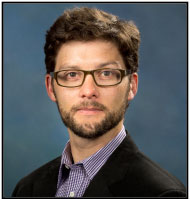
Jonathan Engle
Jonathan Ward Engle (Inorganic, Isotope and Actinide Chemistry) is among 49 winners, including 22 National Laboratory scientists, of the DOE’s Early Career Research Program awards for 2016. The award for outstanding researchers in universities and DOE national laboratories supports the development of individual research programs of scientists early in their careers and stimulates research careers in the disciplines supported by the DOE Office of Science.
Engle’s winning proposal, “Nuclear Data for Spallation Neutron Radioisotope Production,” will establish valuable international collaborative relationships with the potential to create a sustained fast-neutron cross-section measurement program, characterizing new medium-energy neutron-induced reactions relevant to radioisotope production and facility design, and enhance ongoing efforts to improve the predictive power of nuclear codes on supercomputers. The project will also enable evaluation of achievable yields of radioisotopes and consideration of radioisotopic impurities likely formed in reactions of current interest to the DOE’s Isotope Program.
Engle intends to determine how useful really fast neutrons might be for making very specialized radionuclides that cannot be created any other way. These neutrons come from spallation sources such as the Los Alamos Neutron Science Center (LANSCE) and very intense proton beams. The research will also gather fundamental nuclear data that would be useful for other scientific work, such as space science, stellar nucleosynthesis and dosimetry for large facilities.
The Early Career Research program provides year-round salary plus research expenses for researchers based at the DOE’s national laboratories. The funding is for the first year of planned five-year research grants, subject to congressional appropriations.
Engle’s research focuses on radionuclide production. He has 10 years’ experience in nuclear medicine research, operating and maintaining particle accelerators and performing a wide variety of radionuclide-based targetry and radiochemistry for medical and environmental applications. Engle has worked as an analytical and preparative radiochemist and in positron emission tomography (PET) scanning. He has built automated radiochemistry modules for routine and novel syntheses and worked to establish PET radiotracer production facilities.
In 2012, Engle joined LANL to work in the DOE, Office of Science Isotope Production Program at LANSCE’s linear accelerator and continue research in radioisotope production. With Brookhaven National Lab and international collaborators, the Isotope Program at Los Alamos supplies the U.S. national need for medical radioisotopes used for imaging procedures and calibrating imaging equipment.
Engle’s winning proposal, “Nuclear Data for Spallation Neutron Radioisotope Production,” will establish valuable international collaborative relationships with the potential to create a sustained fast-neutron cross-section measurement program, characterizing new medium-energy neutron-induced reactions relevant to radioisotope production and facility design, and enhance ongoing efforts to improve the predictive power of nuclear codes on supercomputers. The project will also enable evaluation of achievable yields of radioisotopes and consideration of radioisotopic impurities likely formed in reactions of current interest to the DOE’s Isotope Program.
Engle intends to determine how useful really fast neutrons might be for making very specialized radionuclides that cannot be created any other way. These neutrons come from spallation sources such as the Los Alamos Neutron Science Center (LANSCE) and very intense proton beams. The research will also gather fundamental nuclear data that would be useful for other scientific work, such as space science, stellar nucleosynthesis and dosimetry for large facilities.
The Early Career Research program provides year-round salary plus research expenses for researchers based at the DOE’s national laboratories. The funding is for the first year of planned five-year research grants, subject to congressional appropriations.
Engle’s research focuses on radionuclide production. He has 10 years’ experience in nuclear medicine research, operating and maintaining particle accelerators and performing a wide variety of radionuclide-based targetry and radiochemistry for medical and environmental applications. Engle has worked as an analytical and preparative radiochemist and in positron emission tomography (PET) scanning. He has built automated radiochemistry modules for routine and novel syntheses and worked to establish PET radiotracer production facilities.
In 2012, Engle joined LANL to work in the DOE, Office of Science Isotope Production Program at LANSCE’s linear accelerator and continue research in radioisotope production. With Brookhaven National Lab and international collaborators, the Isotope Program at Los Alamos supplies the U.S. national need for medical radioisotopes used for imaging procedures and calibrating imaging equipment.
Ning Xu given journal’s Outstanding Reviewer Award
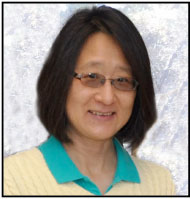
Ning Xu
The Editor-in-Chief of the Journal of Radioanalytical and Nuclear Chemistry presented Ning Xu (Actinide Analytical Chemistry, C-AAC) with the 2014-2015 Outstanding Reviewer Award. Xu received the award at the First International Conference on Radioanalytical and Nuclear Chemistry at Budapest, Hungary. The award recognizes her invaluable effort and dedication to maintaining the high quality of the journal with rapid review of numerous manuscripts. The journal also invited Xu to serve as a member of the distinguished reviewers’ board of the Journal of Radioanalytical and Nuclear Chemistry. Her name will appear on the covers of the printed issues and the webpages of the journal.
Xu received her PhD in chemistry from the University of Kentucky. She worked at the Environmental Protection Agency before joining the Lab in 2006. Xu also received a NNSA Best-in-Class, Sustainability Champion Pollution Prevention Award this year. Technical contact: Ning Xu
Maruti Mudunuru recognized with Robert J. Melosh Award
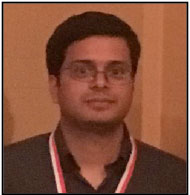
Maruti Mudunuru
The Duke University Department of Civil and Environmental Engineering selected Maruti Mudunuru (Computational Earth Science, EES-16) to receive the prestigious Robert J. Melosh Medal. The Melosh Medal Competition was inaugurated in 1989 to honor Professor Melosh – a pioneering researcher in the area of finite element methods and computational mechanics and former chairman of the department at Duke University. The international competition reflects Professor Melosh’s dedication to the education of young engineers and researchers by providing a forum for student researchers to present their work and interact with each other and with leading researchers in the field. The winner of the Competition, as determined on the basis of a submitted extended abstract and oral presentation of the paper, receives the Robert J. Melosh Medal and a $500 honorarium.
Mudunuru completed a PhD in civil engineering from the University of Houston. His dissertation, titled On Enforcing Maximum Principles and Element-wise Species Balance for Advective-Diffusive-Reactive Systems,” received the University of Houston Cullen College of Engineering’s Best Dissertation Award.
Mudunuru gave a presentation entitled “Structure-preserving Finite Element Formulations for Advective-Diffusive-Reactive Systems” for the Melosh Competition. The work described his PhD thesis research of developing novel finite element methods for multi-component coupled flow and reactive-transport systems. Mudunuru addressed numerical formulation to ensure non-negative values for physical quantities such as concentrations in reactive-transport numerical simulations. The Journal of Computational Physics published part of this research, and the remaining part will soon be submitted for publication.
The Melosh Competition consists of two phases. First, a panel of distinguished researchers in computational mechanics reviews the extended abstracts. Next, the top six papers are selected as finalists, and their student authors are invited to participate in the second phase of the competition, a symposium at Duke University. The symposium features lectures by the members of the distinguished judging panel and talks by all the selected finalists.
Mudunuru joined the Lab in September 2015 as a postdoctoral research associate in EES-16. He is developing physics-informed reduced-order models and inversion methods to understand coupled processes related to enhanced geothermal systems, contaminant transport, fracture networks, and induced seismicity. Satish Karra and Hari Viswanathan (EES-16) mentor him. Technical contact: Maruti Mudunuru
Nan Sauer receives Pollution Prevention Lifetime Achievement Award
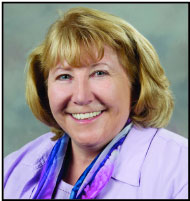
Nan Sauer
Nan Sauer, Associate Director for Chemistry, Life, and Earth Sciences (ADCLES) and long-time Lab manager, received a Lifetime Pollution Prevention Achievement Award from the Environmental Stewardship Group in the Environmental Protection and Compliance Division. She was recognized both for her personal commitment to pollution prevention activities over the years and for actively encouraging her staff to reduce pollution in their programs. Sauer was recognized with the award during a Pollution Prevention ceremony on April 20, 2016.
Over her 25-year career at the Lab, Sauer has been responsible for the inspiration and oversight of many projects that have been examples of the essence of pollution prevention. Through the use of innovative approaches such as green chemistry, her leadership has led to multiple permanent changes in the use of process and support chemicals, changes that are safer, cleaner and smarter.
Across activities such as computer science, materials science, biosecurity, energy security, and geologic and planetary science, Sauer has challenged her staff – and at times participated directly in projects – to seek ways to protect the environment. A prime example occurred in the early 2000s. At that time, foam-mitigated outdoor shots were the largest source of low-level waste generation at LANL, and DOE had instructed the Lab to reduce low-level waste by 80%. Sauer worked directly with the pollution prevention team to identify alternative containment methods for shots to reduce that waste, developing interim reduction strategies while development proceeded on fully contained vessel shots. This effort reduced the amount of low-level waste disposal and helped improve overall institutional pollution prevention performance. As a manager, Sauer influenced her staff to implement a consistent, long-term effort to reduce waste as well as clean out legacy materials and chemicals. Technical contact: Nan Sauer
Richard Sandberg elected to leadership of LCLS Users’ Executive Committee
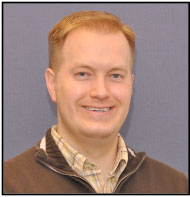
Richard Sandberg
The Linac Coherent Light Source (LCLS) Users’ Executive Committee has elected Richard Sandberg (Center for Integrated Nanotechnologies, MPA-CINT) as vice-chair. A committee member since 2014, Sandberg will lead the committee in helping to improve user operations and facility capabilities. He will become committee chair in October 2016.
DOE’s SLAC National Accelerator Laboratory in California opened LCLS in 2009. LCLS is the world’s first hard x-ray laser. It includes six experimental stations and attracts proposals in a range of disciplines that include biology, soft and hard materials, matter in extreme conditions, chemistry, atomic, molecular and optical; and methods and instrumentations. Sandberg’s discipline is matter in extreme conditions. THE LCLS has enabled Sandberg and collaborators to create the first-ever in situ images of void collapse in explosives using an x-ray free electron laser. The DOE, Office of Science, Office of Basic Energy Sciences supports the laser.
Key technologies originally developed at Los Alamos in the 1980s and 1990s, such as the radio frequency photoinjector and high-brightness electron beams, enabled the x-ray free electron laser (XFEL) facilities currently in use worldwide. Moreover, Los Alamos was part of a multi-laboratory collaboration that designed and built the Linac Coherent Light Source.
LANL’s proposed experimental facility MaRIE (Matter-Radiation Interactions in Extremes) will be the world’s highest energy hard XFEL. It will be used for time-dependent materials research to help researchers design the advanced materials needed to meet 21st-century national security and energy security challenges.
Sandberg holds a PhD in physics, with a certificate in optics, from the University of Colorado – Boulder. He joined LANL in 2009 as a Director’s Postdoctoral Fellow and became a staff scientist in 2011. Technical contact: Richard Sandberg
Lab employees honored with NNSA Defense Programs Awards of Excellence 2014
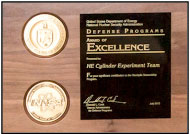
The Awards recognize significant achievements in quality, productivity, cost savings, safety, or creativity in support of NNSA’s Stockpile Stewardship Program. Brigadier General S. L. Davis (NNSA Principal Assistant Deputy Administrator for Military Applications) and Bob Webster (Principal Associate Director of Weapons Programs, PADWP) presented the 2014 NNSA Defense Programs Awards of Excellence during a ceremony at the Lab. Technical contact: Jon Ventura
The following team and individual received awards:
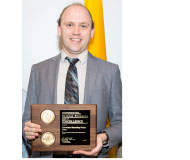
Forrest Doss
The Alternative Secondary Design Study Team studied secondary design concepts outside core stockpile work. This group has grown a capability to develop alternative secondary concepts that might be important for the future for our own stockpile assessments and also the assessments of other nation-states. Technical contact: Forrest Doss
(Not pictured here: Nicholas Lanier, Kim Simmons, Kris Eriksen, and Bernie Wilde.)
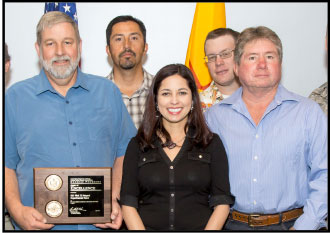
The B61 Mod 12 Integral Experimental Team.
The B61 Mod 12 Integral Experimental Team completed two highly complex, dynamic experiments to provide critical data for proposed engineering changes for the B61 Mod 12. The data met all weapons physics and engineering expectations and enabled the B61-12 team to make informed decisions on the engineering design changes for the Life Extension Program (LEP). Technical contact: Larry Hull
In picture at left: (From left): Larry Hull, Isaac Martinez, Theresa Montoya, Joel Heidemann, and Joe Lynch. Not pictured: Delfido Anaya, Leland Maestas, Pamela Scott, Kenneth Huff, Langdon Bennett, and Cindy Zoldi.

The B61-12 Thermal Team
The B61-12 Thermal Team undertook a comprehensive effort to understand the effect of longer duration flight environments for the B61-12. The longer flights exceed the legacy conditions for components, in particular the insensitive high explosive (IHE). LANL integrated the atmospheric temperature data and defined flight parameters into a two-dimensional axisymmetric thermal-mechanical FEA model to create comprehensive simulations of flight environments and NEP component responses at various atmospheric temperatures and flight parameters. Technical contact: James Gurule
In picture: The B61-12 Thermal Team. (From left): David Collins, Charlie Crane, Michael Inbody, Keeley Costigan, James Gurulé, Loren Hatler, and Trevor Tippetts. Not pictured: Timothy Stone.
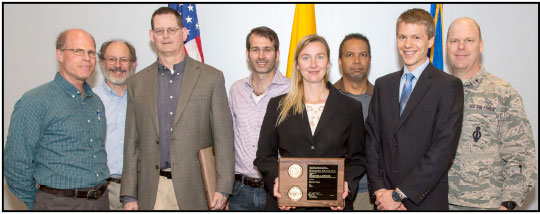
The Barrier Team
The Barrier Team developed and assessed the effects of detonation wave attenuation and propagation on re-light of the insensitive high explosive PBX 9502 following propagation through inert barriers. The work produced new inert materials for delaying or preventing re-light across a barrier in an explosive assembly and improved knowledge about means of shaping propagated detonation waves and “deadening” PBX 9502. Technical contact: Christina Scovel
Photo: (From left): Rick Gustavsen, Bob Webster, David Becker, Scott Jackson, Christina Scovel, Kim Simmons, Erik Moro, and Brigadier General S. L. Davis. Not pictured: Dana Dattelbaum, Ralph Menikoff, Tariq Aslam, Elizabeth Francois, Scott Jackson, Josh Coe, Jay Kucko, Patrick Bowden, Cindy Sandoval, Eric Weis, and Wendy Vogan-McNeil.
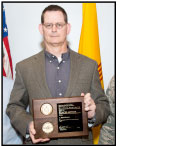
David Becker
David Becker received an Individual Award for the Plutonium Course for the Intelligence Community. He participated in the creation of a plutonium (Pu) metallurgy course on very short noticed and delivered a high quality product to the Intelligence Community that was highly praised. The GS sponsor wrote of Becker’s performance “we were tasked and funded to provide a Pu Metallurgy course to my sponsors as a follow on to the Nuclear Design Proliferation general courses we teach in PADGS on a regular basis. This was a completely new course, and Dave was critical to making this happen.” Technical contact: David Becker
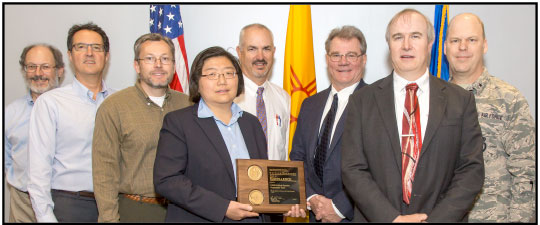
The Chemistry and Metallurgy Research Replacement Critical Decision Preparation Team
The Chemistry and Metallurgy Research Replacement (CMRR) Critical Decision (CD) Preparation Team met the overwhelming technical and administrative challenges and delivered a revised CD-1 package to NNSA in record time – only 2 months – and the DOE Deputy Secretary approved it in August 2014. Technical contact: Tim Nelson
Photo: (From left): Bob Webster, Everett Trollinger, Drew Kornreich, Amy Wong, Brett Kniss, Timothy (Tim) Nelson, David Armstrong, Brigadier General S. L. Davis. Not pictured: Craig Bachmeier, Jeffrey Baldwin, Daniel Cuillier, Leisa Davenhall, Tracy Drake, Douglas Dugan, C. Shane Ellard, Megan Farrell, Stephen Fong, Mary Hall, David Hampton, Robert Hanson, Vance Hatler, Joseph Jackson, Randy Janke, Joshua Jenkins, Jeffrey Kelley, K. Bryan Koehler, Tim Leckbee, Michael Levine, Jeanette Martinez, Benjie Martinez, John Matonic, Tamera Meyer, John Michele, Jeremy Mitchell, Mark Myatt, David O’Flynn, Karen Oden, Reginald Page Jr., Robert Parker, Michael Parkes, Mark Patrick, Ray Patterson, Amelia Quijano, Octavio Ramos, Robert Sander, Dennis Schoonover, Jeffrey Schroeder, Kent Scotten, Terry Singell, Robert Sledzik, Kathryn Smith, Alice Smith, Wayne Smyth, Anna Swertfeger, James Tingey, Jamie Van Winkle, Robert Van Winkle, Kevin Vancleave, Joni Weamer, Thomas Whitacre, Dorothy Winkler, and Stephen Zuhn.
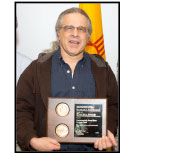
Ray Ristorcelli
The Fundamentally Based Burn Formula Team: The “PDF Burn” model has rationalized our predictive capability for burn by directly coupling a new, fundamentally based, burn equation with the BHR turbulence model. This work has closed a long-standing shortfall in our predictive capability and lays the groundwork for additional advances that will facilitate coupling of physics within our Advanced Simulation and Computing (ASC) codes. Technical contact: Ray Ristorcelli
Photo: The Fundamentally Based Burn Formula Team. Ray Ristorcelli. Not pictured: Nicholas Denissen and James Fincke.
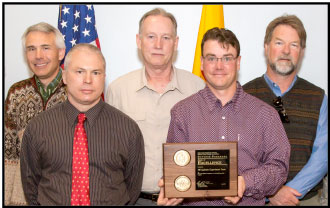
The High Explosive (HE) Cylinder Experiment Team
The High Explosive (HE) Cylinder Experiment Team investigated the initial conditions for boost in a physical regime relevant to nuclear weapon primaries. The data provide a stringent validation constraint for models recently implemented in the hydrodynamic design codes and provide the very first experimental insight into these boost related phenomena. Technical contact: Russell Olson
Photo: (Left to right): Russell Olson, Darin Westley, Peter Pazuchanics, Josh Tybo, and Danny Sorenson. Not pictured: Nicholas S. P. King (deceased).
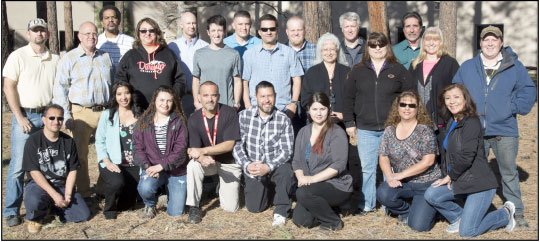
The Hydro, Subcritical and Device Assembly Team
The Hydro, Subcritical and Device Assembly Team has increased production of test objects over the past 5 years starting at 55 units in 2010 and reaching an impressive build of some 246 units in 2014. This work has been accomplished without safety incidents using a rigorous conduct of operations protocol. Technical contact: Robert Gonzales
(Back row, from left): Todd Kimbrough, Tim White, Martin Griego, Ryan Ader, and Danny Gallant. (Middle row, from left): Rudy Originales, Robert Miller, Amy Martinez, Robert Gonzales, Angelo Echave, Loretta Gurule, Juanita Romero, Jan Redding, and Jacob Sutton. (Front row, from left): Marty Vigil, Desiree Velasquez, Brenda Quintana, Matthew Martinez, Aaron Archuleta, and Alyssa Reeves. Not pictured: Julie Chavez-Hare, Leland Maez, Janette Montoya, Mark Montoya, Todd Mulder, Cliff Polston, Patrick Rodriguez, Kristine Terrones, Berlinda Trujillo, and Robert Villareal.
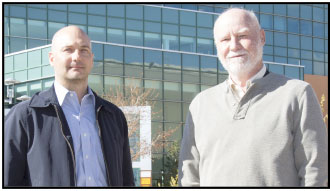
The Los Alamos-Sandia Lithium Fluoride (LiF) Window Correction Team
The Los Alamos-Sandia Lithium Fluoride (LiF) Window Correction Team conducted experiments at LANL’s high performance powder gun and Sandia’s Z machine to understand the refractive index of shocked LiF, a common window material in dynamic compression experiments. Using the correct window correction factor is critical for interpreting experimental data and applying it to simulation codes. Technical contact: Jason Scharff
Photo: (From left): Jason Scharff and Robert Hixson. Not pictured: Marcus Knudson and Paulo Rigg.
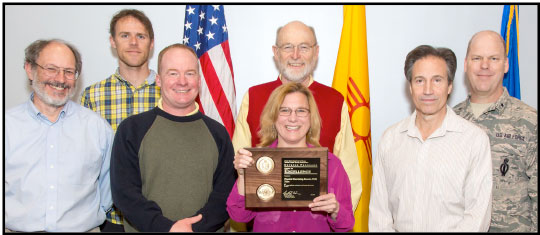
The Physical Uncertainty Bounds (PUB) Team
The Physical Uncertainty Bounds (PUB) Team presented posters at the Nuclear Explosives Code Developers Conference (NECDC) that described a new overall method including the development of PUBs for several physics processes including material flow stress, shear modulus and high explosive equation of state. The PUBs project has positively impacted resource allocation by enabling scientific efforts to be directed based on physical uncertainties and model deficiencies. Technical contact: Diane Vaughan
Photo: (From left): Bob Webster, Sky Sjue, Mike Prime, Diane Vaughan, Andy Fraser, Dean Preston, and Brigadier General S. L. Davis. Not pictured: Gowri Srinivasan, Kendra Van Buren, James Howse, Leonid Burakovsky, Nick Hengartner, Patrick Talou, and Denise Neudecker.

The LANL Practicum 2 Team:
The LANL Practicum 2 Team: The Practicum is a valuable training exercise for design physicists and weapon engineers in system design and collaborating with engineers at Sandia National Laboratories. The exercises involve designing a weapon system with desired characteristics and with a given set of limitations. The LANL Practicum 2 team developed a design that demonstrated the high level of quality of design capabilities. Their work garnered significant attention from stakeholders and collaborators nationwide. Technical contact: Ryan Kalas
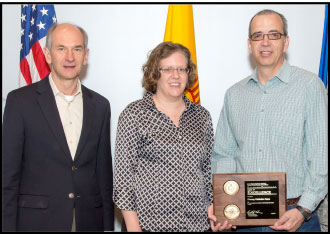
The Primary Validation Team
The Primary Validation Team has done an outstanding job expanding the number of models in the Primary Validation Suite and turning it into a world-class capability. The suite now includes entries for more than 60 nuclear tests covering all the families relevant to the enduring stockpile plus other events that provide important scientific insights into primary operation. Technical contact: Leslie Sherrill
Photo: (From left): Robert Chrien, Leslie Sherrill, and Rendell Carver. Not pictured: Garry Maskaly, Mark Anderson, Lee Ankeny, S. Davis Herring, Robert Pelak, Barbara DeVolder, and Karlene Maskaly.
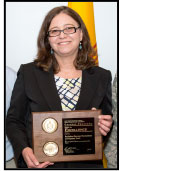
Andrea Laboriau
The Radiation Damage Mechanisms of Polymers Team brought together a diverse suite of capabilities to identify the dominant chemical and physical radiation damage mechanisms for classes of polymers that play important roles in the stockpile including structural support and component insulation. The team quantified the effects of the damage on the mechanical performance of the materials, and summarized the results in a DOE/NNSA Level 2 milestone report. Technical contact: Andrea Laboriau
Photo: The Radiation Damage Mechanisms of Polymers Team. Andrea Laboriau. Not pictured: Carl Cady, Dana Dattelbaum, Cynthia Welch, John Gill, Dali Yang, Kevin Henderson, Kevin Hubbard, and Jamie Stull.
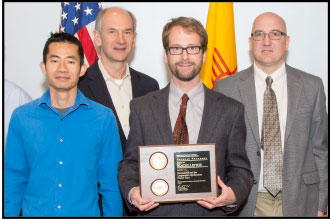
The Secondaries and the Lagrangian Applications Project Team
The Secondaries and the Lagrangian Applications Project Team applied tools from the Lagrangian Applications Project (LAP) to problems of importance in secondary design. This effort has been key to growing expertise on both the code team and in the design community for understanding how to best apply LAP tools to stockpile problems of interest. Technical contact: Kris Eriksen
Photo. Secondaries and Lagrangian Applications Project Team. (From left): Jimmy Fung, Robert Chrien, Kris Eriksen, and Thomas Gianakon. Not pictured: Jennifer Donley, Joseph Schmidt, Brandon Smith, Rob Ward, Katie Mussack Tamashiro, and Forrest Doss.
Bioscience
Dynamic error detection method developed for sequence data
Technological advances have made genome sequencing much faster and less expensive. Multiple industries have evolved, each with its own version of a high-throughput, “next-generation” sequencer. However, all of them cut the DNA into smaller fragments to read the sequence of nucleotides, and then put the fragments back together like a puzzle to determine the overall correct sequence. Regardless of the chosen platform, errors in the sequence data can happen. Errors are especially common in sequences that contain a high percentage of the nucleotides guanine (G) and cytosine (C). These two nucleotides are complimentary and bind to each other. When there are many repeated G-C combinations in a row, it can be difficult for the sequencing process to decipher it accurately. LANL bioinformaticists have developed a novel error detection method called ADEPT (A Dynamic Error-detection Program with Trimming). The journal BMC Bioinformatics published their research.
ADEPT relies on an algorithm that assigns a quality score to each sequenced nucleotide and its neighboring nucleotides, together with their positions within the fragment. It then compares this information with a position-specific quality score distribution of all bases within the sequencing run. The quality score reflects the probability of errors at a given position. This tool is better than other error detection methods due to its attention to position and adjacent nucleotides. It is the first tool that dynamically processes data and relies on within dataset information to identify errors.
To test the ADEPT program, the team created a model using several Illumina (one type of sequencing) datasets with known reference genomes from the organisms. Then, the scientists evaluated the performance of ADEPT using four independent datasets that have finished genomes and compared the results to three other error detection tools: ConDeTri, SolexaQA, and BWA. The results showed that ADEPT excelled in identifying true errors in the middle of the reads for all datasets, and outperformed the other tools by identifying a higher percentage of true errors. The ability to identify errors within the middle of reads may be particularly important in analyzing metagenomic data for which there is a large amount of disparate data.
The method used to devise the error model for Illumina data can readily be applied for assessing and detecting errors in other technologies. The key to ADEPT is the analysis of quality scores not only of the base being analyzed, but also the scores of its neighboring bases, and how these relate
to the entire dataset in a position-specific fashion. ADEPT outperforms other tools with respect to identifying true errors without increasing the total errors called. This is particularly true within the middle of reads. Taking into account position-specific scores, neighboring base scores, and relating these to the distribution of scores in a position-specific manner provides ADEPT with a superior true positive error rate. The ability to identify errors within the middle of reads is particularly significant for metagenomic data analysis when the genome coverage may be very low. The methodology provides a framework that could be extended to other sequencing technologies.
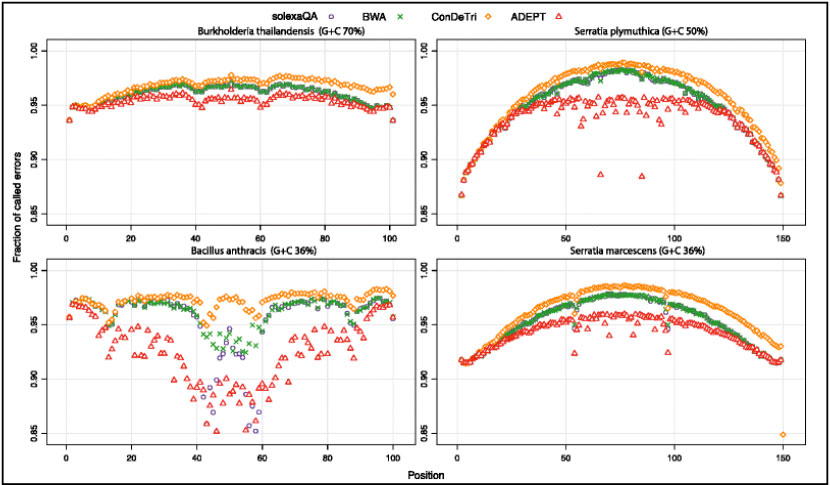
Figure 1. The fraction of incorrectly identified errors for diverse samples. The four samples include Bacillus anthracis AMES, Serratia sp. FGI94, Burkholderia thailandensis, and Serratia plymuthica RVH1 and are of differing G + C content and/or sequenced on different physical machines. The four methods shown are SolexaQA (purple circle), BWA (green X), ConDeTri (orange diamond) and ADEPT (red triangle). Y-axis represents the fraction of called errors that are incorrect (i.e. the tools called these errors but they are correct bases); X-axis represents the position within the reads.
Reference: “ADEPT, a Dynamic Next-generation Sequencing Data Error-detection Program with Trimming,” BMC Bioinformatics 17, 109 (2016); doi: 10.1186/s12859-016-0967-z. Authors: Shihai Feng, Chien-Chi Lo, Po-E Li, and Patrick S. G. Chain (Biosecurity and Public Health, B-10).
This study was funded in part by the Joint Genome Institute through the DOE Office of Science, National Institutes of Health, U.S. Department of Homeland Security, and the U.S. Defense Threat Reduction Agency. The ability to detect sequencing errors supports the Lab’s Global Security and Energy Security mission areas and the Science of Signatures science pillar. Technical contact: Patrick Chain
Capability Enhancement
SPIDER scales up to measure plutonium fission product yields
Accurate nuclear data are central to the development of robust theoretical fission models, which guide advances in nuclear weapons and nuclear energy technologies. Researchers have designed, assembled, and commissioned the Spectrometer for Ion DEtermination in fission Research (SPIDER) at the Los Alamos Neutron Science Center (LANSCE) to measure fission product yields. The goal is to reduce uncertainties in the energy-dependence of fission product yields.
Following engineering studies at LANSCE, the design is being finalized on a scaled-up SPIDER instrument capable of achieving target accuracy for plutonium (Pu). SPIDER provides unambiguous identification of fission product mass by utilizing ultra-fast micro-channel plate detectors and axial ionization chambers to register the velocity and kinetic energy, respectively, of coincident fission products. The instrument simultaneously acquires data on the total kinetic energy release and prompt neutron emission per fission event.
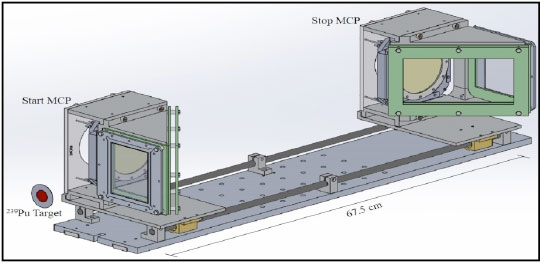
Figure 2. Time-of-flight assembly for one side of the SPIDER spectrometer. Each sub-assembly consists of a micro-channel plate (MCP) detector, delay-line anode housed below the micro-channel plate, and a set of electrostatic mirrors above the micro-channel plate detectors. As shown, a particle would traverse the system from left to right.
Figure 2 depicts the time-of-flight section for one side of SPIDER. Some components are suppressed for clarity. As fission products pass through a thin carbon film, secondary electrons are emitted and guided onto the micro-channel plate detector via electrostatic deflectors. The micro-channel plate acts as an electron multiplier, and the collected charge marks the instant the particle passes the micro-channel plate. The difference between the stop and start micro-channel plate signals is a measure of the time it takes to traverse the distance separating the detectors or a measure of velocity.
Due to the large-area (7.5 cm diameter) of each micro-channel plate, some deviation from the nominal micro-channel plate separation distance occurs. A set of position-sensitive delay-line anode detectors is positioned beneath each micro-channel plate to measure the effective flight path distance. The delay-line anodes consist of two bare copper wires wound orthogonally to produce x and y position coordinates that map the area of the carbon foil. The team implemented an improved read-out scheme for the delay-line anode assemblies during the 2015 run cycle at the Lujan Center. Figure 3 reveals the relevant position data for the fission events from 239Pu. The image of the position hits in the start detector resembles the shape of the target, and that in the stop detector resembles the shape of the stop foil. The halo surrounding the position hits in both histograms arises from low-level electronic noise (dark current) within the micro-channel plate detectors. The middle histogram shows measured deviations from the nominal flight path length of 67.5 cm. The new read-out scheme leads to a good reconstruction of the true fission product velocity and an optimized performance of the time-of-flight section of the spectrometer.

Figure 3. (Left): Position hits registered in the start micro-channel plate. (Center): Effective flight path length of fission products registered by the time-of-flight assembly. (Right): Position hits registered in the stop micro-channel plate.
The improved performance of the position readouts from the delay-line anodes moves SPIDER closer to achieving a 1% mass resolution in fission product yield measurements. Furthermore, a reliable performance of the delay-line anodes is a requisite for the upgrade of the SPIDER spectrometer to a multi-arm device. The team is developing this spectrometer to study fission product properties from fission events induced by fast neutrons, a neutron energy region accessible at LANSCE’s Weapons Neutron Research facility. Researchers anticipate an order-of-magnitude gain in detection efficiency for the larger SPIDER array, making it feasible to measure reactions with reduced fission cross sections. The cylindrical chamber design includes 20 micro-channel plate delay-line anode assemblies, 16 axial ionization chambers, and measures slightly over 152 cm in diameter.
This new instrument will provide a means to measure properties of a fissioning system across a wide excitation energy range and will be enable collection of valuable nuclear data to constrain fission models. SPIDER’s mission is to measure fission product yields from plutonium. However, there are other potential uses for the instrument such as measuring neutrino production cross sections to provide insight into the discrepancy between calculated and observed production of neutrinos in nuclear reactors.
Reference: “The SPIDER Fission Fragment Spectrometer for Fission Product Yield Measurements,” Nuclear Instrumentation Methods A 788, 59 (2015); doi: 10.1016/j.nima.2015.02.032. Authors: Krista Meierbachtol (Advanced Nuclear Technology, NEN-2); Fredrik Tovesson, Matthew Devlin, and John O’Donnell (LANSCE Weapons Physics, P-27); Charles Arnold (Systems Design and Analysis, NEN-5); Todd Bredeweg (Nuclear and Radiochemistry, C-NR); Justin Jorgenson (Applied Engineering Technology, AET-5); Alexander Laptev (Pu Facilities, SB-PF); Arnie Sierk (Nuclear and Particle Physics, Astrophysics and Cosmology, T-2); Morgan White (X Computational Physics, XCP-5); R. Blakeley, A. A. Hecht, L. E. Heffern, and D. Mader (University of New Mexico); and D. Shields (P-27 and Colorado School of Mines.
The Laboratory Directed Research and Development (LDRD) program funded construction of the SPIDER instrument, and NNSA Science Campaign 1: Primary Assessment Technologies funds the current measurement program. The work supports the Lab’s Nuclear Deterrence and Energy Security mission areas and the Nuclear and Particle Futures science pillar through the capability to measure nuclear fission product yields. Technical contact: Fredrik Tovesson
Lab’s first scanning probe microscopy capabilities for plutonium
The Laboratory’s first-ever scanning probe microscopy (SPM) capabilities dedicated for plutonium surface studies became operational in the Target Fabrication Facility (TFF). A collaboration between Engineered Materials (MST-7), Materials Science in Radiation and Dynamics Extremes (MST-8), Nuclear Materials Science (MST-16), Physical Chemistry and Applied Spectroscopy (C-PCS), and Nuclear and Radiochemistry (C-NR) established this unique Los Alamos capability. It is focused on both fundamental atomic-scale plutonium surface science investigations necessary to validate theoretical modeling codes and macroscopic signatures studies of plutonium surfaces relevant to the nuclear weapons engineering community.
The capability includes a glove box-housed atomic force microscope (GB-AFM) and an ultra-high vacuum scanning tunneling microscope (UHV-STM) along with low energy electron diffraction (LEED) and Auger electron spectroscopy (AES) techniques that provide complimentary structural and chemical plutonium surface analysis. The AFM instrument is contained within an inert atmosphere glove box due to the radiological and toxic plutonium hazards. The GB-AFM and UHV-STM instruments are equipped with gas dosing systems for high resolution studies of plutonium surface physical-chemical property changes (e.g. morphology, local defect and electronic structure, composition, etc.) induced by gas exposures under ambient pressure and ultra-high vacuum, respectively. Unlike electron microscopy, these techniques can nondestructively producing 3-D surface topography images with nanometer-scale resolution in all three directions.
The team used UHV-STM and GB-AFM instruments to conduct surface imaging of a mechanically polished 7 atomic % gallium-stabilized δ-plutonium coupon. The GB-AFM collected precise images, but the surface quality was not smooth enough for UHV-STM to obtain atomically resolved images. Figure 4 shows AFM images obtained from the surface of a coupon prepared at the Lab’s PF-4 facility. The topography image revealed a surface with an average roughness of approximately 9 nm and features with widths ranging from 50-150 nm and heights from 30-60 nm. The simultaneously obtained phase contrast image indicated sub-μm scale variations of mechanical properties on the δ-Pu surface, which are not always representative of surface topography. The team is conducting studies of the nature of these plutonium surface irregularities (likely related to chemical composition, crystallographic orientation variations, and mechanically induced damage from polishing) and atomically smooth plutonium surface preparations.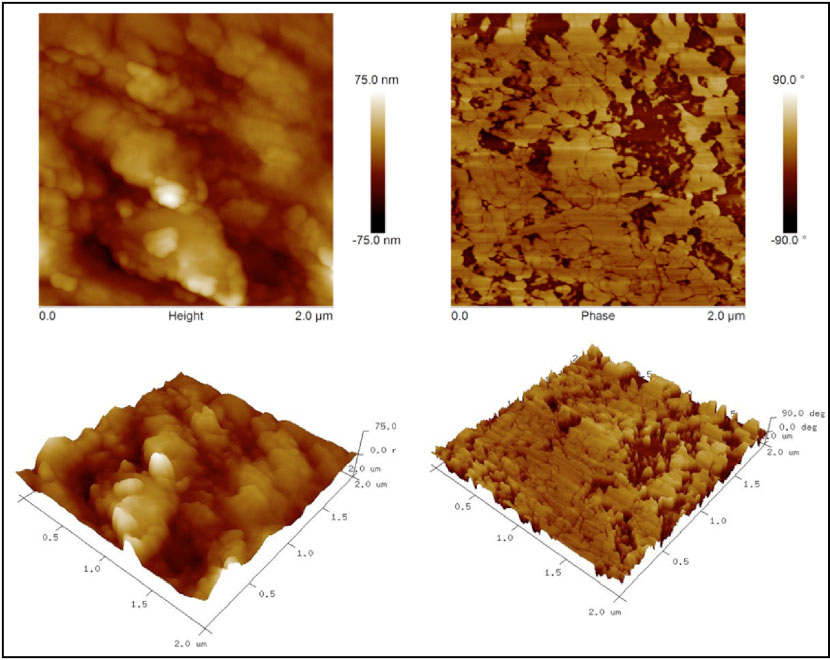
Figure 4. 3-D AFM height (corresponding to surface topography) and phase (representing surface mechanical properties) images of as-received 7 atomic % gallium-stabilized δ-plutonium taken simultaneously from the same region.
Participants include Igor Usov, Miles Beaux, Miguel Santiago-Cordoba, and Douglas Vodnik (MST-7); Adam Zocco (MST-7, now with Detonator Technology, W-6); William Blumenthal (MST-8); Mike Ramos, Scott Richmond, Tom Venhaus, and Jeremy Mitchell (MST-16); Stephen Joyce (C-PCS); and Marianne Wilkerson (C-NR).
The Laboratory Directed Research and Development (LDRD) program (Marianne Wilkerson, principal investigator) sponsored the initial establishment of the capabilities aimed at plutonium characterization. NNSA Science Campaign 1 (William Blumenthal, project lead) funded a major refurbishment and upgrade, necessary to ensure that these capabilities remain state of the art for the long term. This work supports the Lab’s Nuclear Deterrence mission area and the Materials for the Future and Science of Signatures science pillars. Technical contact: Igor UsovTrident delivers a short duration, extremely intense neutron source
Los Alamos pioneered a novel short duration yet extremely intense neutron source using a short-pulse laser. At the Lab’s Trident laser facility, one of the most intense and powerful short-pulse lasers in the world, a laser beam can be concentrated to peak intensity up to 1021 W/cm2. The beam, interacting with an ultrathin (sub-micron) deuterated plastic CD (or CD2) foil target, drives a high-energy deuteron beam, which produces neutrons in a beryllium converter. This neutron source features high intensity and directionality, approximately 1010 fast neutrons per steradian per shot with extremely short neutron pulse duration i.e. on the order of a few nanoseconds.
Researchers have used the source to demonstrate global security applications. An example is the development of a new generation of detectors for active interrogation of potential clandestine nuclear material. The work demonstrates a bright moderated neutron source that could enable a new generation of additional nuclear physics experiments and applications. This includes nuclear resonance transmission analysis for isotopic assay of irradiated nuclear fuel and bulk-temperature measurements in shock-driven material experiments as needed for MaRIE (Matter-Radiation Interactions in Extremes, the Lab’s proposed experimental facility), neutron diffraction diagnostics, neutron therapy etc.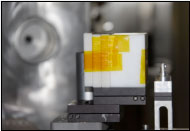
Photo. The picture shows the high-density polyethylene moderator block (white), with the embedded beryllium ion-to-neutron converter, and the target holder. The team experimentally optimized the thickness of the moderator by adding layers of polyethylene and monitoring the thermal neutron production.
The team fully characterized the energy spectral components of the source in each pulse by a set of neutron time-of-flight detectors. The results revealed the fast neutron component coming from the initial neutron production, as well as the epithermal, thermal, and cold (few meV) components after the moderation of the neutrons. For the first time, the researchers detected evidence of a neutron resonance in a laser-driven neutron experiment. The results show the path toward neutron resonance spectroscopy as a diagnostic for MaRIE and the first direct comparison of a laser-driven neutron source with a spallation source such as the Los Alamos Neutron Science Center (LANSCE).
The team included: Nuclear Engineering and Nonproliferation (NEN), Physics (P), and Materials Science and Technology (MST) divisions; Darmstadt University (Germany); and the University of California – Berkeley. The Laboratory Directed Research Development Program (LDRD) program funded the Los Alamos researchers. A. Favalli (Safeguards Science and Technology, NEN-1) and S. Vogel (Materials Science in Radiation and Dynamic Extremes, MST-8) led the work. The research supports the Lab’s Global Security mission area and the Nuclear and Particle Futures and Science of Signatures science pillars. Technical contact: Andrea Favalli
Thorium target manufacturing for production of a cancer-fighting isotope
Los Alamos, Brookhaven, and Oak Ridge national laboratories are developing a large-scale accelerator production capability for actinium-225 (225Ac), a rare, alpha emitting radioactive isotope that could attack cancer cells without damaging nearby healthy cells. The team uses encapsulated thorium target assemblies to produce 225Ac via irradiation with high-energy proton beams at accelerator facilities located at Brookhaven and Los Alamos labs. Oak Ridge chemically processes the irradiated targets. Researchers and clinicians worldwide use the isolated 225Ac for initial evaluation studies.
The pressing need to provide enough 225Ac for clinical trails of medicines based on this isotope drives the tri-lab effort. The current supply of 225Ac available to the research and commercial market is inadequate. The tri-lab team, through the auspices of DOE’s National Isotope Program, is developing chemical processing techniques and production-scale targetry to prepare for 225Ac manufacturing.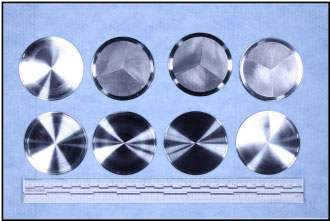
Photo. (Left to right): Weld test specimen and three thorium target assemblies made at the Sigma Facility at Los Alamos National Laboratory, to be irradiated at Brookhaven National Laboratory.
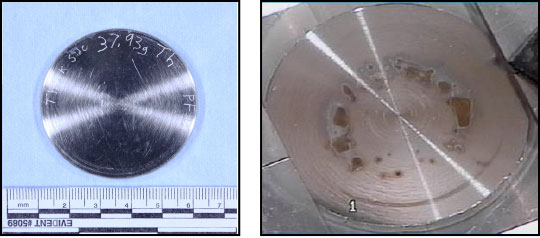
Photos. (Left): Thick thorium target assembly made at Sigma for the Los Alamos Isotope Production Facility. (Right): A thorium target after irradiation at the Los Alamos Isotope Production Facility. Circularly-rastered proton beam interactions with the target surface caused the scorching pattern.
None of this work would be possible without the capability to manufacture encapsulated thorium capsules for irradiation. The Sigma Complex at Los Alamos is the only place in the United States with the equipment, expertise, and access for melting, forming, and machining thorium, which is radioactive. The Isotope Program has collected a ready supply of thorium at Los Alamos for the effort.
Over the past two years, LANL metallurgists have produced 11 thorium targets for the Los Alamos Isotope Production Facility, where researchers test the capsules to ensure their viability during irradiation and measure the 225Ac yield to address the increasing worldwide clinical demand. The Los Alamos Neutron Science Center (LANSCE) is one of the nation’s most powerful proton linear accelerators, providing protons at 100 MeV to the Isotope Production Facility for large-scale generation of radionuclides needed by the isotope community.
In a recent achievement showing Sigma’s growing role in the tri-lab effort, Los Alamos machinists, welders, and metallographers manufactured three extremely thin thorium irradiation targets for Brookhaven National Laboratory. The fabrication of these targets required exceptional skill and precision in order to meet Brookhaven’s specifications.
Brookhaven’s specifications for 0.015-inch-thick thorium targets in a capsule with a 0.020 inch-thick window presented new challenges. Jeff Scott rolled existing thorium plate to the 0.015-inch-thick dimension, and Jeff Robison machined the thorium target pieces. Rick Hudson machined the thin Inconel capsule halves, which Matt Dvornak electron beam welded together with the thorium inside. The welding test specimen contained a 0.015-inch-thick stainless steel disk to mimic the thorium target. A hole bored into the test specimen’s center for helium leak testing confirmed that the target did not leak. Thee Brookhaven Linac Isotope Producer will irradiate these targets in support of ongoing 225Ac product evaluation studies.
The team (formerly Metallurgy, MST-6 now Sigma Division, SIGMA) established the versatile thorium target manufacturing capability over the past two years: Richard Hudson, Andrew Duffield (now with MET-2, Pit Integrated Technologies), Matthew Dvornak, Jesse Martinez, Matthew Strandy, Joel Montalvo, Bo Folks, Jeffery Robison, Tim Beard, Victor Vargas, Maria Pena, Hunter Swenson, Daniel Aragon (now with Prototype Fabrication-Weapon Fabrication Services), Jeffery Scott, Kester Clarke, Robert Forsyth, Daniel Javernick, James Foley, and Jason Cooley.
The DOE, Office of Science funds the Isotope Development and Production for Research and Applications subprogram in the Office of Nuclear Physics for the work, which is part of the broader tri-lab effort to produce 225Ac via high-energy accelerators. Eva Birnbaum (Science Program Office-Office of Science, SPO-SC) is the LANL lead for the Isotope Development and Production for Research and Applications subprogram and Kevin John (SPO-SC) leads the tri-lab Research Effort to Provide Accelerator-Produced 225Ac for Radiotherapy. This new capability at Sigma supports the Lab’s national security mission area and Materials for the Future science pillar. Technical contact: Jason C. Cooley
Physics
Los Alamos collaborates at the world’s largest and newest stellarator experiment
The Wendelstein 7-X (W7-X) stellarator recently began operations at the Max Planck Institute for Plasma Physics in Germany, with the help of American researchers from several universities and institutes including Los Alamos. The W7-X machine is the world’s largest superconducting magnetic fusion experiment. It has optimized three-dimensional magnetic fields designed to test an alternative to the tokamak approach to harnessing fusion energy. Presently no commercially viable technology exists to exploit fusion energy, a potential source of clean, plentiful, reliable power.
Preparations for this start of operations, with US-designed hardware and software, have been ongoing for the last four years by a DOE-sponsored U.S.-German laboratory collaboration involving Princeton Plasma Physics Laboratory, Oak Ridge National Laboratory and LANL. The team plans to demonstrate steady state, high-temperature (100 million °C) plasmas for up to 30 minutes after the machine is fully operational with deuterium in the next three years.
Los Alamos developed and installed a high-resolution visible and infrared camera diagnostic set needed to study the effects of 3-D magnetic geometries on the plasma edge, mainly interactions with the armored walls inside W7-X. The Germans already have several lower resolution imaging systems. Glen Wurden (Plasma Physics, P-24) recommended using an infrared camera developed for the U.S. military, which offered the highest resolution available at that time. He and John Dunn (P-24) designed two imaging systems: one for initial operations with the poloidal graphite limiter, and another for use in a future phase with a test divertor unit and an Oak Ridge scraper element. Wurden obtained optical access at the stellarator via a large sapphire vacuum window, which can be mounted on several diagnostic ports. Software written in Matlab with multi-core graphics image processing enables real-time data acquisition and analysis.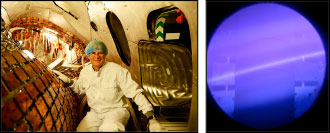
Photos. (Left): Glen Wurden in the stellarator’s vacuum vessel during camera installation, with one hand on tile-backing plates and the other on a manned-entry port. Cameras capture images of the plasma effects on armored tile segments. (Right): Wurden used a high-resolution visible imaging diagnostic to take this single-frame, 30-ms-exposure image of W7-X’s first plasma. The image shows one of the five graphite limiters, visible behind the plasma as several tiled segments.
The W7-X’s inaugural run occurred in December 2015. Magnetically shielded cameras – visible (400-700 nm) and mid-band infrared (3-5 μm) – shared a nearly identical view of the limiter through a sapphire window on a port. Both systems offer sub-mm spatial resolution and 10-ms time resolution, while viewing three of the limiter tiles. Wurden and collaborators will compare heat flux patterns observed on the limiter with numerical predictions corresponding to different plasma diffusivities.
The DOE Office of Science’s Office of Fusion Energy Sciences (Program Director Don Rej) funded the work, which supports the Lab’s Energy Security mission area and the Nuclear and Particle Futures science pillar by building the scientific foundation needed to develop a fusion energy source. Technical contact: Glen Wurden
Theoretical
Seminal paper on nuclear masses guides search for superheavy elements
The 1995 paper “Nuclear Ground-State Masses and Deformations,” written by Peter Moller (Nuclear and Particle Physics, Astrophysics and Cosmology, T-2) and collaborators has accumulated more than 2500 citations according to Scopus. Nearly 21 years later, it is a top-ten downloaded paper from the Atomic Data and Nuclear Data Tables (ADNDT) website.
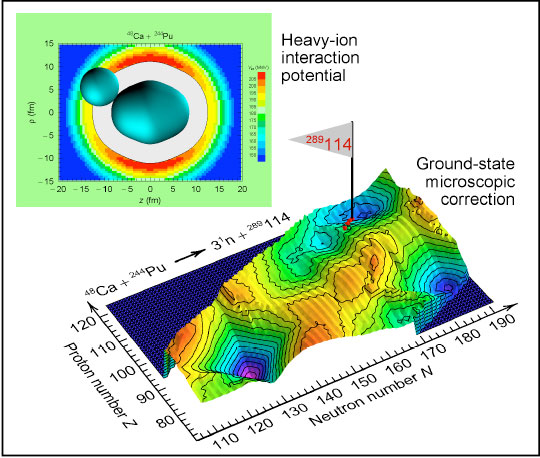
Figure 5. Illustration of nuclear-structure properties of importance for superheavy-element (SHE) production and stability. (Upper left): The potential barrier between a projectile and target in the heavy-ion reaction used to produce a product with 114 protons. (Lower graphic): A theoretical calculation of the microscopic corrections to the ground-state masses of nuclei for a region extending from the vicinity of lead to heavy and superheavy nuclei. Local minima in this quantity correspond to increased nuclear stability arising from particularly large gaps in the single-particle spectra such as occur near the doubly magic 20882 Pb126 nucleus. After the design of this figure, the element with 114 protons has been named Flerovium (Fl) after Georgii Nikolaevich Flerov. The red dots show the observed nuclides in the alpha-decay chain of this element.
Since 1940, researchers have sought to discover new elements heavier than uranium. Scientists found that stability with respect to fission successively decreases beyond uranium. Some investigators thought that it would be impossible to discover elements with atomic number much beyond Z=104 because the decay half-lives had decreased to a few milliseconds. However, other researchers suggested that elements would be sufficiently stable to allow observation near the next magic proton number Z=114 and N=184. According to Moller, the first mass table (published in 1981) and the 1995 table have been extensively used by the experimental teams at GSI, Darmstadt, JINR in Dubna, and at Riken in Wakoshi, Japan both to guide the design of experiments and to interpret the properties of the elements observed – mainly their alpha-decay energies and their fission stability. The experimentalists have detected the entire sequence of elements from atomic number 107 to 118. The predictions agree well with the experimental observations.
Moller and collaborators have developed a “new edition” of nuclear ground-state masses and deformations: FRDM (2012). Increased computer power made possible consideration of additional effects that were already specified in the 1995 paper but impossible to consider at the time. On today’s computers, the 1981 study would take 10 minutes and the 1995 study 3 hours. The FRDM (2012) calculation took about 50000 hours by current standards. The ADNDT website published it in March 2016.
References:
“Nuclear Ground-state Masses and Deformations: FRDM(2012),” Atomic Data and Nuclear Data Tables 109-110, 1 (2016); doi: 10.1016/j.adt.2015.10.002. Authors: P. Moller and A. Sierk (T-2), T. Ichikawa (Kyoto University) H. Sagawa (RIKEN Nishina Center and University of Aizu).
The work supports the Lab’s mission areas and the Nuclear and Particle Futures science pillar. Technical contact: Peter Moller





